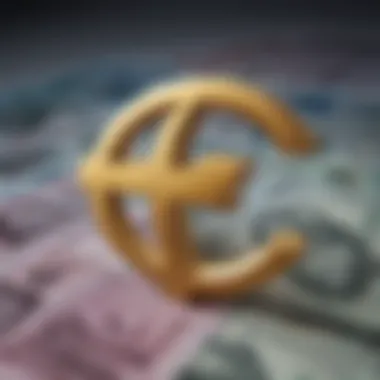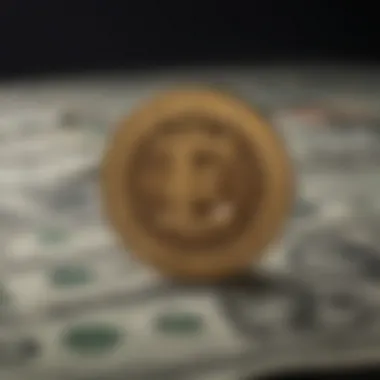Understanding the Euro Exchange Rate: Key Insights


Intro
The interplay between currencies often captures the attention of financial analysts and investors alike. In the realm of international finance, the trade between the euro and the US dollar stands as a vital component. Understanding the fluctuations and factors influencing this exchange rate is not just for economists; it's crucial for anyone looking to make sound financial decisions. This exploration sets the stage for a detailed breakdown of how these currencies interact, with a particular focus on historical data, economic theories, and practical insights tailored for today’s market.
Economies are constantly evolving, influenced by both local and global factors. The euro against the dollar is impacted by diverse elements like political events, economic releases, and market sentiments. As we turn the pages on this narrative, we will delve into key terms that enhance comprehension, strategies for investing based on risk appetite, and ultimately equip readers with the knowledge needed to navigate the complexities of the forex landscape.
Key Terms and Definitions
Grasping the concepts surrounding exchange rates requires familiarity with certain financial terms that frequently surface in discussions about currency trading.
Overview of Key Financial Terms
- Exchange Rate: the value of one currency for the purpose of conversion to another. For instance, if 1 euro equals 1.10 dollars, that is the exchange rate.
- Forex Market: the global market for trading national currencies against one another. It's one of the most liquid markets worldwide.
- Currency Pair: two different currencies that are quoted against each other, such as EUR/USD.
- Pip: short for 'percentage in point,' a unit of measurement for the change in value between two currencies.
Common Investment Jargon
- Bull Market: a market condition where prices are rising or are expected to rise.
- Bear Market: a market condition where prices are falling or are expected to fall.
- Volatility: a statistical measure of the dispersion of returns for a given security or market index, indicating the degree of variation in trading prices.
Understanding these terms sets a solid foundation for deciphering the movements of the euro against the US dollar.
Expert Insights
Navigating the dynamic forex environment can be daunting, especially when it comes to creating strategies that align with individual risk profiles.
Strategies for Different Risk Profiles
- Conservative Investors: Might choose to engage in hedging strategies using options to minimize potential losses while securing potential gains. A traditional approach may involve waiting for favorable exchange rates before making a move.
- Moderate Investors: May engage in diversification, spreading investments across various currency pairs, including the euro and the dollar. This allows for a semblance of balance and risk reduction.
- Aggressive Investors: Typically, they look for quick trades and are willing to accept high levels of risk for potentially high returns. Day trading and using leverage are common practices in this group.
Market Analysis and Trends
Understanding how to analyze market conditions is crucial. Here are several aspects to keep an eye on:
- Economic Indicators: Reports such as GDP growth rates, unemployment rates, and inflation can provide clues about currency strength. For example, strong US job reports might strengthen the dollar against the euro.
- Political Climate: Political instability can lead to volatility in exchange rates. Events like elections or policy changes should be monitored closely.
- Central Bank Policies: Interest rates set by the European Central Bank or the Federal Reserve can significantly affect currency value. Changes tend to impact trading strategies heavily.
Remember, informed decisions in trading stem from sound analysis. Taking the time to understand the underlying factors can mean the difference between profit and loss.
As we look further into the euro and dollar dynamics, it is essential to sift through historical data and contemporary trends to identify patterns that inform future trading decisions. Understanding the intricacies of the euro-dollar relationship is paramount for aspiring investors aiming to elevate their understanding of the foreign exchange market.
Intro to Currency Exchange Rates
Currency exchange rates are more than just numbers displayed on a screen; they form the backbone of international trade and finance. Shifting exchange rates reflect not only current economic conditions but also sentiments about the future. When considering an investment across borders or planning to travel abroad, a sound understanding of exchange rates can make a substantial difference in choices and outcomes.
Definition of Exchange Rates
An exchange rate defines how much of one currency you can exchange for another. For example, if the exchange rate between the euro and the US dollar is 1.20, it means one euro can be exchanged for 1.20 US dollars. This variable rate is subject to fluctuation based on a myriad of factors including supply and demand dynamics, market speculation, and geopolitical events. When currencies are traded, their value is influenced by their purchasing power. Thus, understanding exchange rates is pivotal for anyone engaging in global transactions, be it individuals embarking on travels or companies sourcing goods internationally.
Importance of Understanding Currency Markets
Understanding currency markets is crucial for various reasons:
- Economic Impact: Exchange rates influence prices of imports and exports, which can affect local economies. A strong euro means European goods may be pricier for American buyers.
- Investment Decisions: Investors need to consider currency movements as they impact overseas investments. Ignoring these fluctuations could result in a dampened return on investment.
- Travel Budgeting: If one plans a trip to Europe, knowing the current exchange rate helps in budgeting. A strong US dollar can lead to savings when converting to euros.
In addition, currency markets operate in a highly interconnected global system, where changes in one region can ripple through others. Understanding how exchange rates can shift based on various factors equips individuals and businesses alike to navigate this intricate landscape with more confidence.
Overview of the Euro and US Dollar
In the backdrop of today’s fluctuating financial landscape, grasping the dynamics surrounding the Euro and US Dollar is pivotal. These two currencies don’t just represent their respective geographical regions; they are intertwined in a complex web of global commerce and finance. This section will elucidate the economic background of the Euro and the significant role that the US Dollar has in the world, explaining how each currency affects international trade and investment decisions.
Economic Background of the Euro
The Euro, adopted by 19 of the 27 European Union member states, was introduced on January 1, 1999. It aimed to facilitate smoother trade, allowing for a more robust economic framework across nations that share trade and economic policies. Interestingly, the Eurozone’s creation emerged from Europe’s tumultuous history, especially post-World War II; it was both a symbolic and practical step towards unity and economic stability within Europe.
The European Central Bank (ECB) plays a crucial role in steering monetary policy for the Euro, focusing on maintaining price stability. In practice, this means setting interest rates and managing inflation to ensure the currency remains strong against its peers. Economic indicators, such as GDP growth, employment statistics, and trade balances, all feed into how investors perceive the Euro's value. Periodically, some countries within the Eurozone face economic challenges, leading to considerable debates about fiscal discipline and the efficacy of a shared currency. For example, nations like Greece have faced struggles trying to balance their budgets while adhering to Eurozone regulations, demonstrating the complexities of shared fiscal oversight.
Furthermore, the Euro is characterized by its position in global finance, where it ranks as the second most traded currency. It Euros functions as a reserve currency, held by central banks across the globe, which underlines its importance on the international stage. Whether in trade for commodities like oil or as a base for loans, the Euro’s influence is substantial and growing.
The Role of the US Dollar in Global Finance
The US Dollar (USD) is often considered the leading global currency, serving as the backbone for international trade transactions. Dollar dominance is a result of historical, economic, and political factors, including the size of the US economy and the confidence it commands in the financial markets. Since the Bretton Woods Agreement in 1944, the dollar has assumed a preeminent role; it is the go-to currency for commodities like oil, gold, and other major goods, which makes it indispensable for countries around the world.


The Federal Reserve, America’s central bank, influences the USD’s strength through its monetary policy. By adjusting interest rates, managing inflation, and even engaging in practices like quantitative easing, the Fed directly impacts the dollar’s value relative to other currencies, including the Euro. Moreover, when investors are jittery, they often flock to the dollar, perceived as a safety net during tumultuous periods, further reinforcing its status as a safe-haven asset.
Another noteworthy aspect of the US Dollar’s role is its influence on debts and loans globally. Countries often issue bonds and loans denominated in USD, which can raise complicated issues for nations with weaker currencies. For example, when the dollar strengthens against the Euro, European countries holding dollar-denominated debts may find repayment more challenging. Hence, fluctuations in the exchange rates between the two currencies can significantly affect their financial relationships.
Factors Influencing the Euro to US Dollar Exchange Rate
Understanding the euro to US dollar exchange rate isn’t just about numbers; it’s about grasping the multifaceted elements that drive currency fluctuations. Several factors, from interest rate movements to inflation rates and geopolitical climates, combine to create a dynamic atmosphere in which the value of the euro against the dollar is continuously shifting. By recognizing these elements, investors, traders, and financial enthusiasts can better navigate this complex landscape, planning their moves accordingly.
Interest Rate Differentials
One of the most significant determinants of currency exchange rates lies in the interest rates set by central banks. When the European Central Bank (ECB) raises interest rates, the euro typically strengthens against the dollar. This happens because higher interest rates offer better returns on investments denominated in euros, attracting foreign capital. Conversely, if the Federal Reserve increases rates in the US while the ECB remains stagnant, investors might flock to dollar-denominated assets, leading to a drop in the euro's value.
The concept of carry trade also comes into play here. Traders borrow in low-interest-rate currencies (like the euro) and invest in high-yield currencies (like the dollar), creating demand for the dollar which can push its value higher. This relationship indicates that minor shifts in interest rates can lead to larger movements in the exchange rate. Therefore, keeping a finger on the pulse of monetary policy announcements is vital for anyone looking to understand or engage with the euro-dollar exchange.
Inflation Rates Comparison
Inflation is another key factor that impacts currency exchange rates. If inflation in the Eurozone is lower than in the US, the euro maintains its purchasing power better than the dollar. Low inflation often signals that a central bank may hike interest rates, as it gives them room to do so without stoking excessive price rises.
When inflation rises sharply in the US, it can erode the purchasing power of USD, which might lead the Federal Reserve to adjust its interest rate policy. A higher inflation rate in the US compared to the Eurozone could encourage traders to sell off dollars in favor of euros, which would lead to the euro appreciating relative to the dollar.
"Inflation dynamics can really shake things up, creating unpredictable sandwiches in the currency market that just don't settle too easily."
Political Stability and Economic Performance
Finally, political stability plays a crucial role in determining currency strength. A politically stable Eurozone can inspire investor confidence, encouraging inflows into euro-denominated assets. On the opposite end, political turmoil in the US, like contentious elections, legislative gridlock, or economic downturns, could lead to volatility in the dollar's value. Investors typically seek safety during uncertain times, favoring currencies perceived as strong or stable, making the euro a desired hold if European politics are steady compared to the US.
Economic data, like GDP growth rates, unemployment statistics, or trade balances, also have a say in how currencies perform against each other. Strong economic performance in the Eurozone often enhances the euro's strength, making it more competitive against the dollar.
In the grand scheme of things, appreciating these interconnected factors equips investors to make more informed decisions. Understanding the nuances of interest rates, inflation, and political matters is key to mastering the euro to US dollar exchange rate.
Historical Trends of the Euro Exchange Rate
Examining the historical trends of the euro exchange rate against the US dollar is crucial for grasping how these two currencies interact in global markets. These trends not only provide valuable insights into economic health but also help investors and traders strategize effectively. Understanding past movements can shed light on future expectations and enhance decision-making.
Long-term Trends in the Euro to USD Rate
The long-term trends of the euro against the US dollar reveal a tale of resilience and fluctuation. Since its introduction in 1999, the euro has experienced various phases, reflecting economic events, monetary policies, and political changes in the Eurozone and the United States.
In the early 2000s, the euro struggled, often trading below parity with the dollar. Investors had their reservations, drawing confidence from US economic strength at the time. However, the tide turned by 2002, when the euro began to gain traction, largely due to a robust European economy and increasing market confidence in the euro as a strong alternative to the dollar.
Over the years, this trend continued, culminating in a peak in 2008, when one euro was worth more than 1.5 US dollars. Factors contributing to this surge included economic stability within the Eurozone and ongoing concerns about the US mortgage market and its implications for the economy.
Most importantly, tracking such long-term trends helps individuals and companies make more informed decisions. Without understanding these historical dynamics, one might misinterpret current market conditions.
Recent Volatility and Its Causes
In recent years, the euro to US dollar exchange rate has been marked by volatility. Notably, in the wake of the COVID-19 pandemic, rates swung widely due to the uncertainties surrounding economic recoveries. The euro fluctuated significantly, often in response to fiscal measures taken by the European Central Bank (ECB) and the Federal Reserve.
Here are some key causes of this volatility:
- Monetary Policies: The divergence between the ECB’s and the Federal Reserve’s approaches to stimulus has moved markets. With the US Federal Reserve tightening its policies, while the ECB maintained a more relaxed stance, fluctuations became inevitable.
- Geopolitical Tensions: Events such as Brexit negotiations and other geopolitical issues have led to short-term shocks and market reactions, causing traders to reassess the value of the euro relative to the dollar.
- Economic Data Releases: Key indicators such as unemployment rates, GDP growth figures, and inflation readings have always created ripples in exchange rates. When the eurozone reported stronger-than-expected economic growth, for instance, it often resulted in an appreciation of the euro against the dollar.
It’s essential to remain aware of these fluctuations. A grasp of what fuels volatility not only bolsters confidence but also equips investors with the necessary tools to navigate the complexities of currency markets.
"Understanding historical trends gives individuals a compass in the often tumultuous waters of currency exchange."
In summary, assessing historical trends of the euro exchange rate provides a framework for ongoing analysis. A keen awareness of long-term trends and recent volatility aids in comprehending the intricate and often unpredictable world of currency exchanges.
The Mechanisms of Currency Exchange
Understanding the mechanisms behind currency exchange rates is crucial for anyone involved in global finance, as these rates reflect the economic health of nations and impact trade flows, investment strategies, and even tourism. The interplay of various factors in currency markets can dictate the value of the euro vis-a-vis the US dollar, allowing investors to capitalize on the opportunities and risks presented by exchange rate variations. By delving into how these mechanisms operate, you can navigate the complexities of currency markets more effectively.
How Currency Markets Operate
Currency markets, or foreign exchange (forex) markets, function around the clock, allowing traders to buy and sell currencies across the globe. This continuous operation is facilitated through a decentralized network of banks, brokers, and individual investors. Similar to a bustling market, the forex scene operates through supply and demand. When demand for a currency rises, its value relative to other currencies will likely increase. Conversely, a drop in demand can lead to depreciation.
Moreover, the forex market is characterized by its volatility, often attributed to various factors including economic indicators, market sentiment, and geopolitical events. Traders pay close attention to these elements, analyzing data releases like GDP rates, employment numbers, and consumer confidence indices to forecast currency trends. Since even minor events can sway the market, the need for solid knowledge becomes apparent.
"The forex market is like a giant chess game; understanding your moves is key to winning."
Types of Currency Transactions


Different types of currency transactions play a vital role in shaping the dynamics of currency exchange. Here are some common transaction types:
- Spot Transactions: These are the most straightforward transactions, where currencies are exchanged immediately at the current market rate. This is similar to buying fresh produce at a market stall – you get what you see at the agreed price.
- Forward Transactions: In contrast to spot transactions, forward contracts involve agreements to exchange currencies at a predetermined rate in the future. This is often used by businesses to hedge against unfavorable exchange rate fluctuations.
- Currency Swaps: This involves exchanging principal amounts in different currencies and often includes the exchange of interest payments. It’s like trading baseball cards with someone – you get to enjoy the different cards (currencies) for a while before giving them back.
- Options Transactions: Currency options give traders the right, but not the obligation, to buy or sell a currency at a specific price before a certain date. Think of it as reserving a ticket for a concert; you pay a fee for the option, but you can decide later if you actually want to go.
These transactional types not only cater to different trading strategies but also directly uphold the ongoing fluctuations of exchange rates. Whether you are hedging risks in your international investments or simply exchanging one currency for another during travel, knowing how these mechanisms work can significantly empower your decision-making process.
Practical Implications of Exchange Rate Fluctuations
Understanding currency exchange rates, particularly between the euro and the US dollar, is pivotal in today's interconnected world. The fluctuations in these rates can heavily influence not just the larger scales of international finance, but also individuals making day-to-day financial decisions. Ignoring or misunderstanding these variations can lead to missed opportunities and unnecessary losses.
One important consideration is how exchange rate movements can directly affect the cost of goods and services. For instance, when the euro strengthens against the dollar, European exports become more expensive for American consumers. This can lead to a decrease in demand for these goods, adversely affecting European businesses. Conversely, if the euro weakens, American consumers might find European products more appealing. Hence, fluctuations create a ripple effect impacting both economies, influencing trade balances and consumer habits.
Investors too must keep an eagle eye on currency movements as they can radically change the investment landscape. Exchange rate changes can affect the profits of companies that operate in multiple countries. If a US-based company earns revenue in euros but has to convert it back to dollars, a strong dollar can erode those earnings when the currency is exchanged. This aspect is particularly relevant for investors weighing their portfolio choices, as they should consider the currency risk linked to international investments.
"Currency rates aren't just numbers; they tell a story of economies intertwined, revealing opportunities and risks in the process."
Impact on International Trade
The influence of exchange rates on international trade cannot be overstated. Trade agreements and negotiations often hinge on the health of currency value. When the euro increases in value, it may lead to trade imbalances due to expensive exports. Enterprises that focus heavily on export markets like luxury goods in France or machinery in Germany must stay attuned to these fluctuations to strategize pricing and marketing effectively.
- Increased Costs for Importers: A stronger euro means that goods imported from the US can become pricier, which could lead European companies to look elsewhere for resources or adjust their pricing strategies.
- Competitive Pricing Strategies: European exporters may consider reducing their profit margins to stay competitive when a higher euro makes their products expensive for dollar-based consumers.
This constant adjustment dances like a game of chess between countries, as each tries to navigate the implications of their currency’s strength.
Effects on Investments and Securities
Investments are like a tightrope walk when currencies shift. For individual investors, being cognizant of the euro to dollar movements can mean the difference between profit and loss. When investing in foreign securities, exchange rates can enhance or dilute the overall returns.
For example, if an investor in the US purchases a stock in a French company, and the euro appreciates against the dollar, the profits on that stock can swell when converted back into dollars. However, if the tables turn, and the euro weakens, not only does the stock performance need to be solid, but the currency conversion can significantly truncate overall gains, or even lead to losses.
Moreover, hedging strategies can be employed to mitigate these effects; investors often use various derivative instruments to protect against adverse currency movements. Some of these strategies involve:
- Forward Contracts: Locking in a current exchange rate for simple future transactions.
- Options: Providing flexibility to decide later what action to take on a currency exchange, whether beneficial or not at the time.
The world of finance is unyielding and complex, and understanding the implications of foreign exchange rates requires serious consideration. By staying informed and responsive, investors not only navigate but harness the intricacies inherent in the euro-dollar dynamics.
Understanding Currency Risk
Currency risk, also known as exchange rate risk, is a crucial aspect that cannot be brushed aside when dealing with international investments or trade. For investors and traders, fluctuations in the value of currencies can significantly impact the profitability of their endeavors. This section will delve into the nitty-gritty of currency risk, highlighting its importance, benefits, and key considerations.
Understanding currency risk is essential because it helps investors make informed decisions based on potential scenarios that could affect their assets. Currency values might not only depend on the economy of the nation but also on the collective sentiment of traders, geopolitical events, and market stability. Therefore, appreciating these dynamics is valuable to protect investments and navigate the ever-changing forex market.
Benefits of grasping currency risk include improved decision-making capabilities, enhanced portfolio management, and the ability to seize opportunities that arise from fluctuating exchange rates. Individuals who are well-versed in these challenges can hedge their positions, thereby mitigating potential losses and maximizing gains when the exchange rates move in their favor.
Identifying Currency Risk Exposure
Identifying where your currency risk lies is the first step to manage it effectively. There are several factors that can expose an investor or company to currency risk:
- Transactional Risk: This involves the possibility of losses due to currency fluctuations during the time between entering into a transaction and settling that transaction. For example, if a U.S. company agrees to buy goods from a European supplier, any movement in the euro versus the dollar during that time could impact the final cost.
- Translation Risk: Companies that operate in multiple countries might face translation risk when their financial statements are converted into their home currency. This risk becomes apparent when the euro fluctuates against the dollar, affecting reported profits or losses.
- Economic Risk: This refers to the broader impact of currency fluctuations on the overall business environment. If an economic downturn affects one currency, it can influence trade patterns, cost structures, and competitive positions on a global scale.
Understanding these exposures is akin to knowing the lay of the land; it allows investors to strategize ahead of time. An investor without a clear picture of their currency risk exposure is like a ship without a compass—likely to drift aimlessly and face potential storms.
Mitigation Strategies for Investors
Now that you know how to spot currency risks, let's discuss how to safeguard yourself against them. Here are some effective strategies:
- Hedging: This involves using financial instruments such as options, forward contracts, or currency swaps to protect against adverse movements in exchange rates. By locking in a rate, you can reduce the uncertainty that comes with currency fluctuations.
- Diversification: Spreading investments across various currencies and markets can reduce overall exposure to any single currency risk. By diversifying, you increase the chances that losses in one currency can be offset by gains in another.
- Regular Monitoring: Keep an eye on economic indicators, political events, and market trends that can influence currency values. Staying informed allows you to react swiftly to changes in the market, thereby reducing potential losses.
- Consulting Experts: Seeking advice from financial analysts or advisors who specialize in currency markets can provide insights that might not be evident or accessible to every investor. Their expertise can help devise a tailored approach to currency risk management.
"In the realm of finance, knowledge is power, and recognizing currency risk is the first step in turning potential pitfalls into stepping stones for success."
By implementing these mitigation strategies, investors can position themselves strategically in a world fraught with currency-related uncertainties, ultimately bolstering their overall financial health.
How to Monitor and Analyze Exchange Rates
Monitoring and analyzing exchange rates is crucial for anyone involved in the forex market, including those who wish to trade currencies or simply understand their investments better. In this section, we’ll examine the key elements related to how to stay updated on the euro to US dollar exchange rate and analyze its movements effectively. The ability to interpret these rates can help you make informed decisions that can significantly affect your financial outcomes.
Utilizing Financial News and Data Sources
In the fast-paced world of currency exchange, information is king. To navigate this landscape, the right financial news and data sources are vital. Subscribing to reputable financial news platforms can provide you with real-time updates on exchange rates. Sites like Bloomberg, Reuters, and CNBC not only report on current rates but also offer analysis on market trends and future forecasts. These platforms cover geopolitical events, economic indicators, and central bank policies that often drive currency fluctuations.
Additionally, consider using dedicated forex news websites, such as Forex Factory or DailyFX, which provide insights specifically geared towards currency trading. Joining forums on reddit.com, like r/Forex, can also provide anecdotal insights and community discussions that may unearth new perspectives.


A well-rounded approach might involve the following:
- Daily financial newsletters: These are sent straight to your inbox, often summarizing overnight market movements and key events to watch.
- Social media updates: Follow economists, trading experts, and financial institutions on platforms like Twitter or LinkedIn for instant chatter on market updates.
- Currency conversion apps: Handy tools like XE Currency enable you to check live rates at any time. These can be especially useful if you often travel or do business internationally.
Make sure you cross-reference multiple sources to ensure a comprehensive understanding of the market. By leveraging various data points, you can develop a more accurate forecast of how rates may change.
Technical Analysis Tools for Forex Traders
Once equipped with the latest news, the next step is interpreting the data through technical analysis. This involves examining historical price charts and patterns to identify possible future movements. As a trader, learning the art of reading these technical indicators is essential.
Forex trading platforms come with built-in charting tools that can simplify the process. You can apply various indicators like moving averages or RSI (Relative Strength Index) to help assess momentum and price direction. Here are some commonly used technical analysis tools:
- Candlestick Charts: Popular for spotting trends, these show the open, close, high, and low prices for a particular time frame.
- Fibonacci Retracement Levels: Traders use these to predict areas of support and resistance by looking at historical price action.
- Bollinger Bands: These can help identify volatility; price movements outside the bands could signify potential trades.
It’s also wise to backtest strategies using historical data. This practice allows traders to see how their approach would have performed in different market conditions. Many platforms provide demo accounts, which let you practice without incurring real losses.
Ultimately, employing both news insights and technical analysis tools can empower you to get a clearer picture of where the euro might head against the US dollar. Keeping an open eye and a data-driven mindset will steer you closer to achieving your trading goals.
"In the world of currency exchange, the well-informed trader is often the most successful one."
When you combine a deep understanding of economic indicators with the skills to analyze trading patterns, your capacity for making sound financial decisions will greatly improve.
Understanding this interplay between data and analysis is essential in a constantly shifting financial landscape.
Expert Insights and Forecasts
Understanding expert insights and forecasts is crucial for anyone navigating the fluctuating waters of currency exchange. This section shines a light on how economic analysts utilize data, models, and current events to make predictions about the euro to US dollar exchange rate.
By examining expert opinions, one can not only identify potential market trends but also understand the underlying factors driving these predictions. Whether you're an investor looking to make informed decisions or simply someone curious about economic currents, grasping expert insights aids in anticipating shifts in currency values, thus allowing for better risk management and strategic planning.
Predictions from Economic Analysts
Economic analysts often analyze a plethora of variables, from interest rates to geopolitical events, to forecast changes in the euro to US dollar exchange rate. They might say, for example, that if the European Central Bank raises interest rates, it could strengthen the euro against the dollar, as higher rates often attract foreign investment.
However, predictions are rarely set in stone. Consider the unpredictable nature of global politics; a sudden change in leadership or policy can send currencies into a tailspin. Economists use models that require being flexible, playing a guessing game of sorts. To help understand how their thoughts shape financial landscapes,
- They can provide semi-annual reports that track key economic indicators.
- They might issue alerts on expected shifts due to upcoming elections or trade negotiations.
"Economic forecasts are educated guesses. The more data we have, the better the guess—yet still just a guess," an analyst once remarked.
Staying tuned to these predictions can give a leg up on currency trading scenarios. One ought to remain cautious, though; an individual’s financial moves based solely on forecasts can be risky. Constantly checking data as well as analysts' predictions helps in making more grounded and informed choices.
Understanding Market Sentiment Indicators
Market sentiment indicators reveal the collective mood of investors regarding a currency pair. These can range from social media sentiment to trading volume statistics. Essentially, they give clues about whether traders are feeling bullish (optimistic) or bearish (pessimistic) about the euro against the US dollar.
One reliable source of information comes from platforms like Reddit and Twitter, where discussions can provide context to market movements. Traders look for patterns, for instance:
- Bullish sentiment: As traders express enthusiasm and belief that the euro will increase in value, there often follows a spike in demand for euros.
- Bearish sentiment: Conversely, a swell of negative speculation could lead to a drop in the euro’s appeal.
Strong market sentiment often correlates with significant movements in exchange rates. Thus, understanding these indicators can be invaluable for timing trades. Those who don’t pay attention to sentiment might find themselves swimming against the current, as markets can behave contrary to what traditional data might suggest.
In essence, combining expert forecasts with market sentiment offers a full-bodied view of what might be on the horizon for the euro to US dollar exchange rate. Without delving into speculative chatter, keeping an ear close to the ground fosters awareness and enhances the decision-making process.
Culmination and Future Outlook
The conclusion and future outlook of the euro-to-US dollar exchange rate encapsulate the essence and nuances discussed throughout this article. It acts as a summation of the various dynamics at play in currency exchange markets, providing readers with a clear framework for understanding the implications of current trends and potential future shifts. Analyzing exchange rates is not just about figures; it is about interpreting economic climates, geopolitical events, and market sentiments that define the financial landscape.
Key to grasping the future of the euro against the dollar is recognizing the interconnectedness of global economies. Factors such as interest rate changes by the European Central Bank and the Federal Reserve can act like dominoes, influencing one another in a ripple effect. For investors, staying vigilant about these relationships is crucial. The sensitivity of the exchange rate to external shocks, such as political upheavals or economic crises, cannot be overstated. Risk management becomes paramount in such scenarios, particularly for those with assets tied to these currencies.
With that in mind, observing future trends is essential. One must track the ongoing developments within the eurozone and how they correlate with US economic policies. The increasing importance of non-traditional factors, such as ESG (Environmental, Social, and Governance) criteria and digital currencies, could inject unpredictability into traditional patterns. This is where foresight becomes invaluable. Keeping an ear to the ground on emerging trends will better equip investors and enthusiasts to navigate future currency fluctuations with confidence.
"The ultimate aim is not merely to predict the future, but to prepare for it. Understanding today’s behavior can illuminate tomorrow’s path."
Summary of Key Takeaways
- Interconnectedness: The euro and US dollar are deeply intertwined, influenced by a range of economic and political factors.
- Monitoring Impacts: Interest rates, inflation, and political stability all play critical roles in determining the exchange rate.
- Emerging Factors: New developments such as ESG considerations and shifts towards digital currencies could shape future trends.
- Risk Management: Understanding currency risk and implementing mitigation strategies are essential for investors, especially in a volatile market.
- Proactive Approach: Staying informed and anticipating changes can help navigate the complexities of currency exchange more effectively.
The Role of Emerging Trends in Currency Exchange
As we gaze into the crystal ball of currency exchange, it's clear that emerging trends are steadily carving a new path in financial markets. Notably, the influence of digital currencies is gaining momentum. With cryptocurrencies and the possibilities of Central Bank Digital Currency (CBDC) forming part of global discussions, we see a landscape shifting under our feet.
Regulatory environments around these digital assets can disrupt traditional exchange rate mechanisms. Following how entities like the European Central Bank approach their own digital euro can provide insight into potential impacts on the euro-to-dollar exchange rate.
Meanwhile, sustainability is at the forefront. Companies with solid ESG practices are increasingly seen as safer investments, affected not just by their profitability but also how they integrate social responsibility into their operations. With these considerations becoming mainstream, investor sentiment could sway more towards currencies associated with sustainable practices.
In summary, keeping an eye on these emerging trends in currency exchange is not merely informative; it’s imperative. The global economic landscape is evolving, and being ahead of the curve allows for savvy and prudent investment strategies moving into the future.















